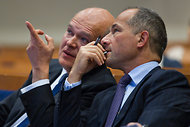Separate data released on Tuesday showed consumer confidence rebounded in August. Consumers were more upbeat about the future even though their assessment of their current standing fell.
Home prices rose 0.9 percent on a seasonally adjusted basis, according to the SP/Case Shiller composite index of 20 metropolitan areas. Economists had expected them to match May’s 1 percent gain.
The data is not likely to alter economists’ expectations that the housing recovery will continue, keeping it a sweet spot for an economy that grew just 1.7 percent in the second quarter.
But mortgage rates have climbed more than a percentage point since late May, largely on expectations that the Federal Reserve will soon start withdrawing its support for the economy by purchasing fewer bonds. Those monthly bond buys had kept long-term interest rates low.
Analysts said that suggests gains in home price gains may continue to slow in the months ahead, particularly since the sharpest rise in rates came in late June and early July, likely after many June contracts were already signed.
“We know housing prices tend to lag. You’re going to see mortgage applications fall first and then starts and permits will move. It will take time to show up in prices,” said Michael Hanson, U.S. economist at Bank of America Merrill Lynch.
Recent data has already shown a decline in mortgage applications and less demand to refinancing existing loans, while a report last week showed sales of new single-family homes fell sharply in July to their lowest level in nine months.
The SP/Case Shiller index showed prices in all 20 cities rose on a yearly basis, led by a 24.9 percent surge in Las Vegas. But only in six did they rise at a faster clip than in the previous month, down from 10 in May.
“Overall the report shows that housing prices are rising but the pace may be slowing,” David Blitzer, chairman of the index committee at SP Dow Jones Indices, said in a statement.
Without seasonal adjustment, prices rose 2.2 percent in June and on a national average were back at their spring 2004 levels. Prices remain well below their 2006 peak, which preceded a far-reaching collapse that helped plunge the U.S. economy into its deepest recession since the 1930s.
Compared to last June, prices rose a healthy 12.1 percent, just shy of the previous month’s 12.2 percent gain.
Still, U.S. consumers’ mood improved this month despite higher borrowing costs. The Conference Board, an industry group, said its index of consumer attitudes rose to 81.5 from 80.3, and the expectations outlook rose to 88.7 form 86.0. Polling ended on August 15.
Worries about building tension in Syria kept market reaction to the data subdued, with U.S. Treasury bond prices trimming gains slightly after the stronger-than-expected confidence data and the back-up in bond yields supporting the dollar. Major U.S. stock indexes were lower.
The confidence data contrasted with an earlier Thomson Reuters/University of Michigan consumer survey showing sentiment slipped in August.
“There is definitely sentiment building that the economy is going to get better, but it’s a bit puzzling to see confidence accelerate when current growth is rather weak,” said Thomas Simons, money market economist at Jefferies Co., adding growth over the past three quarters “has been just barely 1 percent.”
Jim O’Sullivan, chief U.S. economist at High Frequency Economics, said the level of the Conference Board’s expectations index is consistent with a roughly 3 percent rate of growth in real consumer spending, “which would be a pickup from around 2 percent currently.”
Economists expect growth to be stronger in the second half, a view shared by the Federal Reserve, which has based its projected reduction of stimulus on its economic outlook.
Markets largely expect the Fed will begin scaling back its bond purchases next month and possibly end them altogether by mid-2014, though some uncertainty over this remains.
If mortgage rates continue to climb, putting more pressure on housing, the outlook could get cloudier.
Still, rates remain low by historical standards and most economists do not expect the higher costs to end the recovery altogether. In the short-term, it could also spur potential buyers to act before rates rise further.
“It probably wouldn’t be a bad thing if home prices started slowing down a bit from double-digit rates of growth, and I think rising mortgage rates will be offset by the improving economic backdrop, as reflected in the pretty decent consumer confidence number,” O’Sullivan said.
(Editing by Chizu Nomiyama)

Article source: http://www.nytimes.com/reuters/2013/08/27/business/27reuters-usa-economy-homes-index.html?partner=rss&emc=rss




